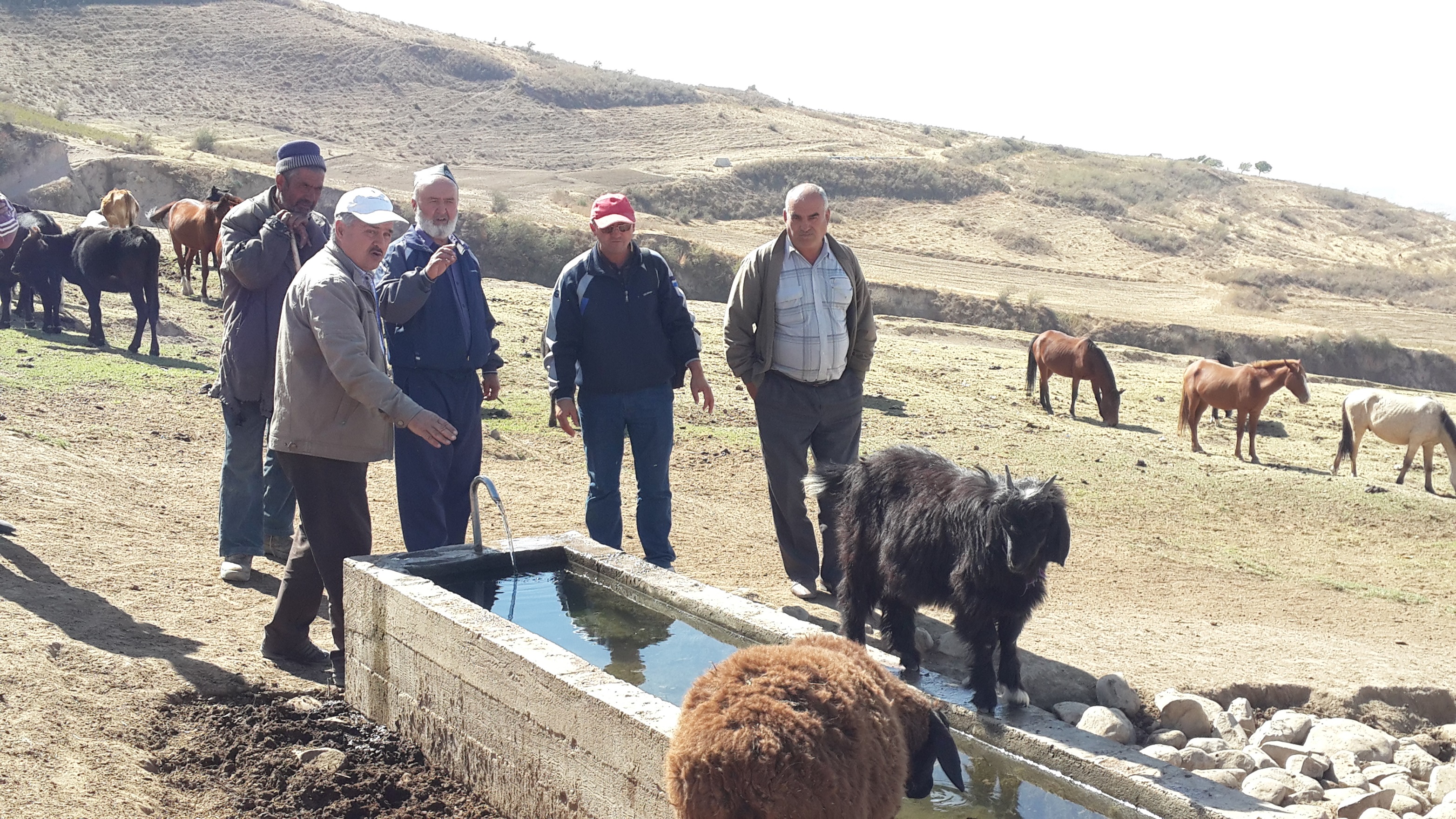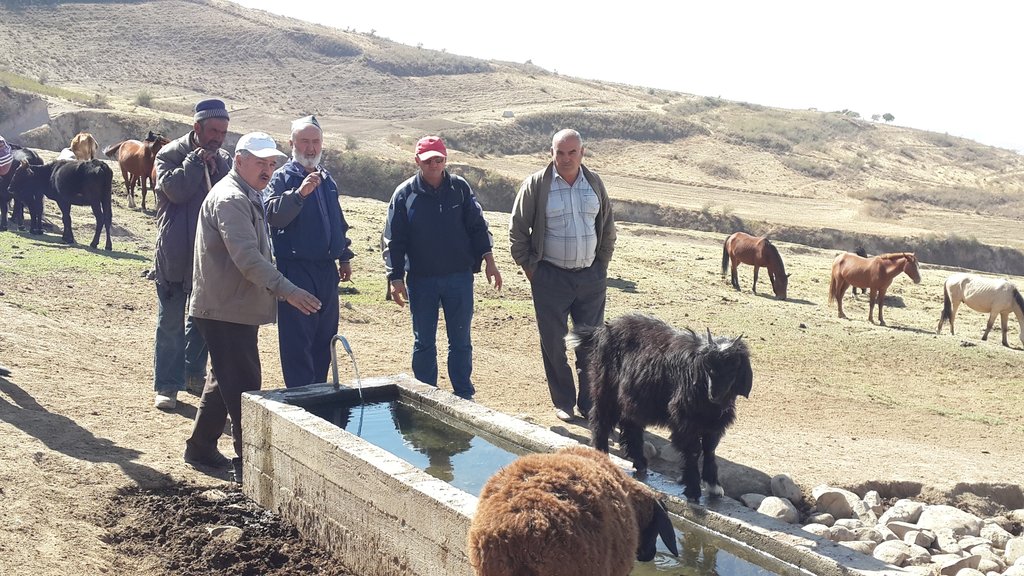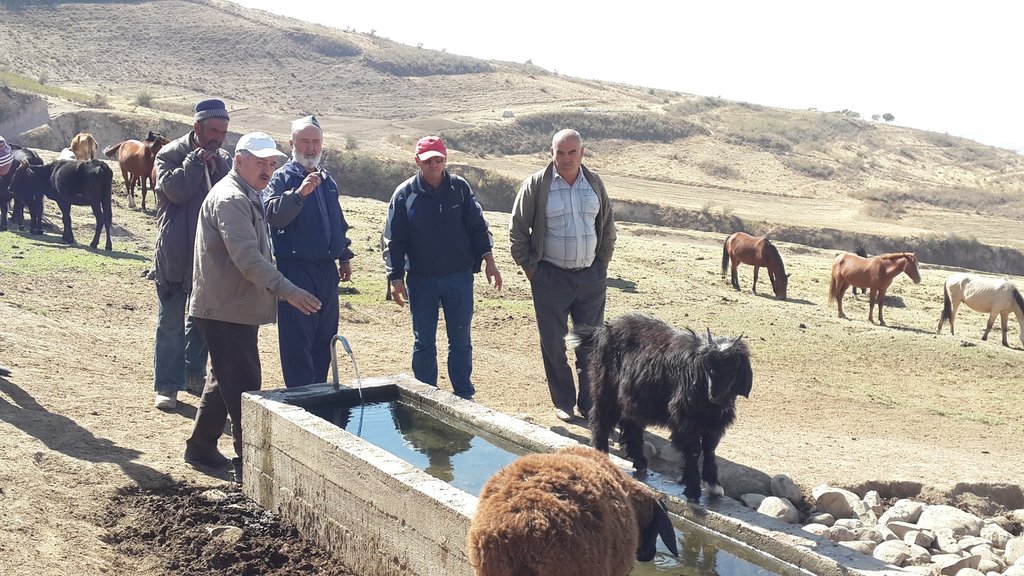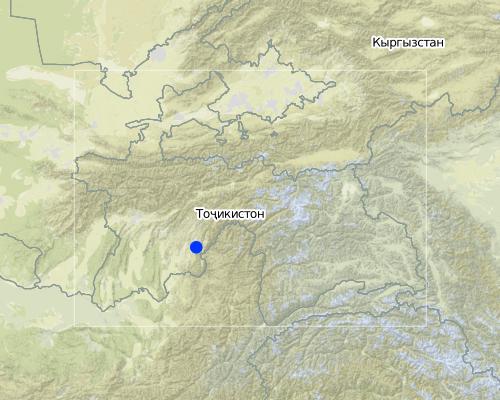Water point for livestock in daily pastures [Tajikistan]
- Creation:
- Update:
- Compiler: Nicole Stolz
- Editor: Sa'dy Odinashoev
- Reviewer: Alvin Chandra
Нуқтаи обнушии чорво
technologies_623 - Tajikistan
View sections
Expand all Collapse all1. General information
1.2 Contact details of resource persons and institutions involved in the assessment and documentation of the Technology
Name of project which facilitated the documentation/ evaluation of the Technology (if relevant)
Book project: where people and their land are safer - A Compendium of Good Practices in Disaster Risk Reduction (DRR) (where people and their land are safer)Name of the institution(s) which facilitated the documentation/ evaluation of the Technology (if relevant)
CARITAS (Switzerland) - Switzerland1.3 Conditions regarding the use of data documented through WOCAT
When were the data compiled (in the field)?
11/10/2016
The compiler and key resource person(s) accept the conditions regarding the use of data documented through WOCAT:
Yes
1.4 Declaration on sustainability of the described Technology
Is the Technology described here problematic with regard to land degradation, so that it cannot be declared a sustainable land management technology?
Yes
1.5 Reference to Questionnaire(s) on SLM Approaches
2. Description of the SLM Technology
2.1 Short description of the Technology
Definition of the Technology:
Water points at daily pasture for livestock in order to reduce erosion and enhance productivity of cattle and livestock
2.2 Detailed description of the Technology
Description:
Water points for cattle is mainly used in semi-arid and arid regions where livestock is kept on daily pastures and water is distant or difficult to access.
Bringing water from springs or other sources to the pastures will greatly increase farm productivity and improve reproduction of animals. Difficult and distant access to water during the day can negatively cost a high amount of animal’s energy. Long distance to water sources will reduce meat supply, milk production and reproductive capacities by up to 50%.
By providing water for pastures, negative effects to livestock productivity can be reduced to a minimum.
In order to implement the technology, water sources have to be found and identified that are within an optimal distance to the and from the different pasture grounds. Sources need to have a perennial output. If water is accessible to a reasonable cost, the issue surrounding land ownership can be solved, i.e. a land is communally owned or the land owner gives user rights to the pasture users.
If water source and land for construction are found in an optimal distance to the different pasture grounds, the drinking water system for animals is designed and constructed. Construction involves spring catchment, laying of pipes and finally installation of the water point.
Besides the direct benefits (i.e. increased productivity and reproduction), the water points at the pastures reduce erosion in often critical locations such as steep slopes surrounding springs. Water points also protect springs from being destroyed or spoiled by the animals. Thus the technology has a risk reduction benefit. A potential negative effect of the technology is a reduction of biodiversity, as drawing of water from catchment springs may result in reduced fauna and flora.
2.3 Photos of the Technology
2.5 Country/ region/ locations where the Technology has been applied and which are covered by this assessment
Country:
Tajikistan
Region/ State/ Province:
Khatlon
Further specification of location:
Muminabad, Dehbaland
Map
×2.6 Date of implementation
Indicate year of implementation:
2014
2.7 Introduction of the Technology
Specify how the Technology was introduced:
- through projects/ external interventions
Comments (type of project, etc.):
By a Caritas Switzerland project
3. Classification of the SLM Technology
3.1 Main purpose(s) of the Technology
- improve production
- reduce, prevent, restore land degradation
- reduce risk of disasters
3.2 Current land use type(s) where the Technology is applied

Grazing land
Extensive grazing land:
- Semi-nomadism/ pastoralism
Intensive grazing/ fodder production:
- Improved pastures
Main animal species and products:
Goats, sheeps, cows producing milk and meat
3.3 Further information about land use
Water supply for the land on which the Technology is applied:
- rainfed
3.4 SLM group to which the Technology belongs
- pastoralism and grazing land management
- surface water management (spring, river, lakes, sea)
3.5 Spread of the Technology
Specify the spread of the Technology:
- applied at specific points/ concentrated on a small area
Comments:
20 water points have been established in the district of Muminabad at specific locations across the watershed.
3.6 SLM measures comprising the Technology

structural measures
- S7: Water harvesting/ supply/ irrigation equipment
3.7 Main types of land degradation addressed by the Technology

physical soil deterioration
- Pc: compaction
- Pu: loss of bio-productive function due to other activities
3.8 Prevention, reduction, or restoration of land degradation
Specify the goal of the Technology with regard to land degradation:
- reduce land degradation
Comments:
Water points in daily pastures lead to less movements of herds from and to natural water sources, as water is brought to the animals. Densitiy of animals around natural water sources lead to damages by tampling through compaction of land, while overgrazing leads to vegetation losses, that lead to increased washing or blowing out of soil. Trampling can as well destroy a natural water source and make it unusable.
4. Technical specifications, implementation activities, inputs, and costs
4.1 Technical drawing of the Technology
Author:
Roziq Halimov
Date:
16/03/2015
4.2 Technical specifications/ explanations of technical drawing
Lengh of the water point is 18 m, depth 0.5 m
4.3 General information regarding the calculation of inputs and costs
Specify how costs and inputs were calculated:
- per Technology unit
Specify unit:
one water point
Specify volume, length, etc. (if relevant):
18m, 4,5m3
other/ national currency (specify):
Tajik Somoni
Indicate exchange rate from USD to local currency (if relevant): 1 USD =:
8.0
Indicate average wage cost of hired labour per day:
45 Somoni (5.5 USD per day)
4.4 Establishment activities
| Activity | Type of measure | Timing | |
|---|---|---|---|
| 1. | Identify water sources (spring detection) | Other measures | early spring and late autumne (at least two years) |
| 2. | Identify where a potential water point should be placed in the pasture area | Other measures | N/A |
| 3. | Identify the land ownership | Other measures | N/A |
| 4. | Design of the system | Other measures | N/A |
| 5. | Spring catchment | Structural | summer |
| 6. | Digging trenches and lay pipes | Structural | Spring |
| 7. | Connecting the tubes to spring catchment | Structural | N/A |
| 8. | Construct water point | Structural | N/A |
4.5 Costs and inputs needed for establishment
If possible, break down the costs of establishment according to the following table, specifying inputs and costs per input. If you are unable to break down the costs, give an estimation of the total costs of establishing the Technology:
15000.0
| Specify input | Unit | Quantity | Costs per Unit | Total costs per input | % of costs borne by land users | |
|---|---|---|---|---|---|---|
| Labour | Labour | 1.0 | 3500.0 | 3500.0 | 20.0 | |
| Equipment | Transport Dushanbe | nr of rund trip | 0.3 | 3050.0 | 915.0 | |
| Equipment | Transport | nr of round trip | 3.0 | 150.0 | 450.0 | |
| Plant material | Tubes | m | 1820.0 | 4.0 | 7280.0 | |
| Plant material | Cement | kg | 1800.0 | 1.06 | 1908.0 | |
| Plant material | Gravel | m3 | 6.0 | 180.0 | 1080.0 | |
| Total costs for establishment of the Technology | 15133.0 | |||||
If land user bore less than 100% of costs, indicate who covered the remaining costs:
Integrated Watershed Management Project, Caritas Switzerland
4.6 Maintenance/ recurrent activities
| Activity | Type of measure | Timing/ frequency | |
|---|---|---|---|
| 1. | Close/open water point during winter time / spring | Management | twice per year |
| 2. | Small repairs | Structural | twice per year |
Comments:
Water points from cement are not that intensive for maintenance, Herders will take care of the water sources as they are daily there. It is important taht tube system is fully covered so taht the animals will not destroy any open laying tubes.
4.7 Costs and inputs needed for maintenance/ recurrent activities (per year)
If possible, break down the costs of maintenance according to the following table, specifying inputs and costs per input. If you are unable to break down the costs, give an estimation of the total costs of maintaining the Technology:
2750.0
| Specify input | Unit | Quantity | Costs per Unit | Total costs per input | % of costs borne by land users | |
|---|---|---|---|---|---|---|
| Labour | Clean outlet of water point | days | 1.0 | 450.0 | 450.0 | |
| Labour | Control catchment and line | days | 1.0 | 450.0 | 450.0 | |
| Equipment | Showel | item | 1.0 | 150.0 | 150.0 | |
| Construction material | Tab | item | 1.0 | 500.0 | 500.0 | 100.0 |
| Construction material | Gravel bed around water point | kg | 20.0 | 20.0 | 400.0 | |
| Construction material | replacement of tubes | m | 200.0 | 4.0 | 800.0 | |
| Total costs for maintenance of the Technology | 2750.0 | |||||
4.8 Most important factors affecting the costs
Describe the most determinate factors affecting the costs:
Cost for tubes and cement, i.e. the distance of the next suitable spring to the pasture area
LAnd ownership: state owned land rented to the Pasture Union
5. Natural and human environment
5.1 Climate
Annual rainfall
- < 250 mm
- 251-500 mm
- 501-750 mm
- 751-1,000 mm
- 1,001-1,500 mm
- 1,501-2,000 mm
- 2,001-3,000 mm
- 3,001-4,000 mm
- > 4,000 mm
Specify average annual rainfall (if known), in mm:
800.00
Specifications/ comments on rainfall:
Spring and autumne rainfall
Agro-climatic zone
- semi-arid
continental climate
5.2 Topography
Slopes on average:
- flat (0-2%)
- gentle (3-5%)
- moderate (6-10%)
- rolling (11-15%)
- hilly (16-30%)
- steep (31-60%)
- very steep (>60%)
Landforms:
- plateau/plains
- ridges
- mountain slopes
- hill slopes
- footslopes
- valley floors
Altitudinal zone:
- 0-100 m a.s.l.
- 101-500 m a.s.l.
- 501-1,000 m a.s.l.
- 1,001-1,500 m a.s.l.
- 1,501-2,000 m a.s.l.
- 2,001-2,500 m a.s.l.
- 2,501-3,000 m a.s.l.
- 3,001-4,000 m a.s.l.
- > 4,000 m a.s.l.
Indicate if the Technology is specifically applied in:
- convex situations
5.3 Soils
Soil depth on average:
- very shallow (0-20 cm)
- shallow (21-50 cm)
- moderately deep (51-80 cm)
- deep (81-120 cm)
- very deep (> 120 cm)
Soil texture (topsoil):
- medium (loamy, silty)
Soil texture (> 20 cm below surface):
- fine/ heavy (clay)
Topsoil organic matter:
- medium (1-3%)
5.4 Water availability and quality
Ground water table:
> 50 m
Availability of surface water:
medium
Water quality (untreated):
good drinking water
Is water salinity a problem?
No
Is flooding of the area occurring?
Yes
Regularity:
frequently
5.5 Biodiversity
Species diversity:
- medium
Habitat diversity:
- medium
5.6 Characteristics of land users applying the Technology
Sedentary or nomadic:
- Sedentary
Market orientation of production system:
- mixed (subsistence/ commercial
Off-farm income:
- 10-50% of all income
Relative level of wealth:
- poor
Individuals or groups:
- groups/ community
Level of mechanization:
- animal traction
Gender:
- men
Indicate other relevant characteristics of the land users:
cattle and livestock grazing is a male task, animals at home are taken care by women
5.7 Average area of land owned or leased by land users applying the Technology
- < 0.5 ha
- 0.5-1 ha
- 1-2 ha
- 2-5 ha
- 5-15 ha
- 15-50 ha
- 50-100 ha
- 100-500 ha
- 500-1,000 ha
- 1,000-10,000 ha
- > 10,000 ha
Is this considered small-, medium- or large-scale (referring to local context)?
- medium-scale
Comments:
range land at community level is about 300 ha, single farmers have about 1 ha cropland
5.8 Land ownership, land use rights, and water use rights
Land ownership:
- state
Land use rights:
- communal (organized)
Water use rights:
- communal (organized)
Comments:
water is owned by the pasture user union
5.9 Access to services and infrastructure
health:
- poor
- moderate
- good
education:
- poor
- moderate
- good
technical assistance:
- poor
- moderate
- good
employment (e.g. off-farm):
- poor
- moderate
- good
markets:
- poor
- moderate
- good
energy:
- poor
- moderate
- good
roads and transport:
- poor
- moderate
- good
drinking water and sanitation:
- poor
- moderate
- good
financial services:
- poor
- moderate
- good
6. Impacts and concluding statements
6.1 On-site impacts the Technology has shown
Socio-economic impacts
Production
animal production
Quantity before SLM:
0
Quantity after SLM:
50%
Comments/ specify:
more meat, milk (avarage 1 l before, after 3 liter) and higher productivity (every second year, now every year)
Water availability and quality
water availability for livestock
Quantity before SLM:
0
Quantity after SLM:
permanently availible
Income and costs
farm income
Quantity after SLM:
30% increase
Comments/ specify:
Animals are healthier. Farmers have more milk and meat due to improved access to water and less movement during the day.
Ecological impacts
Climate and disaster risk reduction
landslides/ debris flows
Comments/ specify:
Erosion reduced due to improved land cover, less livestock destruction to watershed areas and managed water use
6.2 Off-site impacts the Technology has shown
Comments regarding impact assessment:
none
6.3 Exposure and sensitivity of the Technology to gradual climate change and climate-related extremes/ disasters (as perceived by land users)
Gradual climate change
Gradual climate change
| Season | Type of climatic change/ extreme | How does the Technology cope with it? | |
|---|---|---|---|
| annual rainfall | decrease | moderately |
Climate-related extremes (disasters)
Climatological disasters
| How does the Technology cope with it? | |
|---|---|
| cold wave | not well at all |
Comments:
Water points need to be closed during winter time, otherwise the tubes will get destroyed due to freezing.
6.4 Cost-benefit analysis
How do the benefits compare with the establishment costs (from land users’ perspective)?
Short-term returns:
positive
Long-term returns:
very positive
How do the benefits compare with the maintenance/ recurrent costs (from land users' perspective)?
Short-term returns:
very positive
Long-term returns:
positive
Comments:
As land users did not bear the full costs they benefit strongly from the beginning
6.5 Adoption of the Technology
- 10-50%
If available, quantify (no. of households and/ or area covered):
20 water points have been established that are used by more than one village herds
Of all those who have adopted the Technology, how many have did so spontaneously, i.e. without receiving any material incentives/ payments?
- 0-10%
Comments:
The project subsidized the construction of water points. Livestock breeders from other districts have participated by observing the use of technology
6.6 Adaptation
Has the Technology been modified recently to adapt to changing conditions?
No
6.7 Strengths/ advantages/ opportunities of the Technology
| Strengths/ advantages/ opportunities in the land user’s view |
|---|
| Improved water management has improved livestock production by controlled grazing and access to water at daily pasture points. |
| Transporting livestock from steep valley locations to water drinking points was previously labour intensive, a farming activity which has improved due to dedicated water points. |
| Water quality at drinking points are can also be used by farmer and herders. |
| Strengths/ advantages/ opportunities in the compiler’s or other key resource person’s view |
|---|
| Erosion by livestock has reduced as livestock grazing is more controlled compared to before project interventions. |
6.8 Weaknesses/ disadvantages/ risks of the Technology and ways of overcoming them
| Weaknesses/ disadvantages/ risks in the land user’s view | How can they be overcome? |
|---|---|
| Water points and farms are remote. As such construction requires machinery and transport of materials to upper pasture zones are a challenge. |
| Weaknesses/ disadvantages/ risks in the compiler’s or other key resource person’s view | How can they be overcome? |
|---|---|
| Investment costs are still considered to be too high to be fully borne by pasture users | Pasture User Union have been formed which collects fees. The unions help save money for technology investments. |
7. References and links
7.1 Methods/ sources of information
- field visits, field surveys
3 informations, 1 engineer and 1 SLM specialist
- interviews with land users
3 Herders
7.2 References to available publications
Title, author, year, ISBN:
n/a
7.3 Links to relevant information which is available online
Title/ description:
Disaster RIsk Management in Tajikistan
URL:
https://www.caritas.ch/de/was-wir-tun/engagement-weltweit/klimaschutz-und-katastrophenpraevention/
Links and modules
Expand all Collapse allLinks
No links
Modules
No modules





